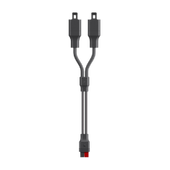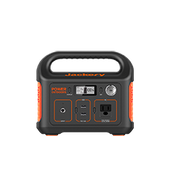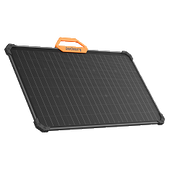There are various reasons to buy a solar-powered dehumidifier, such as to lessen odors in the house, prevent mold development, and reduce skin and respiratory system irritation. A dehumidifier that runs on solar electricity is a huge advantage.
The average dehumidifier uses 0.427 kWh per hour, while the average dehumidifier uses 483 Watts. This indicates that if kept on for 24 hours, it can consume almost 10.24 kWh.
On this page, you will learn what a solar-powered dehumidifier is, how it works, and the solar-powered dehumidifier vs. solar generator for a dehumidifier. Here suggest Jackery solar generators be your ideal dehumidifier power source.
What is Solar Powered Dehumidifier
A dehumidifier purifies the air, eliminates dangerous elements, and produces a dryer, more tranquil outcome. It can cut the air's dampness by thirty to fifty percent.
It would be best to consider many things when selecting the ideal dehumidifier for your house. However, a solar-powered dehumidifier might be something you want to think about if you're searching for a green option.
Solar-powered dehumidifiers are an excellent option for those concerned about their environmental impact. They can also be more cost-effective in the long run than conventional dehumidifiers.
But how do non-electric dehumidifiers work? Well, they work by absorbing the excess moisture from the air. They have natural substances such as silica gel, rock salt, or charcoal that absorb moisture from the air.
How Does A Solar-Powered Dehumidifier Work
A solar-powered dehumidifier removes moisture from the issue area using solar energy and air from the fan units. Using a mix of heating, intake, and extraction, moist air is carried out of the building after removing moisture from the masonry and other materials.
You'll need the dehumidifier, a solar panel, mounting tools for wiring the solar panel components, wire connectors, wire strippers, a screwdriver, a drill, and a saw to install a solar-powered dehumidifier. Install the solar panel on an open area outside your house or an exposed roof first. To support the top, drill holes in it or use stakes.

How Many Watts Does A Dehumidifier Use
Small battery-powered dehumidifiers typically consume 20 watts of electricity, whereas large dehumidifiers draw up to 500-700 watts. Dehumidifiers are standard electrical devices that take moisture out of indoor air. The average humidifier uses 0.427 kWh per hour, while the typical dehumidifier uses 483 Watts on average.
Depending on the dimensions and types of the dehumidifiers, a wide range of wattages are available. Using as little as 20 Watts, a compact tabletop dehumidifier may remove up to a pint of moisture daily. Around 700 Watts are operated by a sizable machine with wheels that extracts 70 pints daily.
Do Dehumidifiers Use a Lot of Electricity?
If you run a dehumidifier drawing 500 watts for 24 hours, it will consume up to 12kW per day. How much it costs to run a dehumidifier will depend on its wattage and how long you run it. For example, if the electricity rate is 16 cents per kWh and the dehumidifier wattage is 300W, the total cost you have to pay for running the dehumidifier for 8 hours will be $11.52 per month. One way to reduce the high electricity cost associated with dehumidifiers is by powering them using solar generators.
How Much Solar Power Does A Dehumidifier Need
A dehumidifier's capacity is commonly expressed in quarts. That shows its capacity to extract pints of water from the air daily. A dehumidifier's energy usage often increases with size. So, if you are wondering if you can run a dehumidifier on solar power, the answer is yes. However, how many watts a dehumidifier uses will directly depend on its pints.
Here is how much power a dehumidifier uses:
|
Dehumidifiers |
Watts |
Length of Use |
Solar Power Needed |
|
22 Pint |
300W |
8H |
2400Wh |
|
30 Pint |
460W |
8H |
3680Wh |
|
50 Pint |
590W |
8H |
4720Wh |
Can A Solar Generator Power A Dehumidifier
Yes, solar generators can power a dehumidifier, especially when there is a power outage or blackout. Solar generators are designed to convert solar energy into electricity and store the AC electricity to power dehumidifiers or other appliances. Jackery Portable Power Stations can charge different types and sizes of dehumidifiers for long hours. These power stations can be easily recharged with wall outlets, car chargers, and Jackery SolarSaga Solar Panels.

Solar Powered Dehumidifier VS. Solar Generator for Dehumidifier
The choice between a solar-powered dehumidifier and a solar generator for a dehumidifier will depend on your specific needs and circumstances. A solar-powered dehumidifier operates directly with the help of solar panels without any battery. On the contrary, a solar generator can not only power dehumidifiers but also other household or outdoor appliances. Here’s a table revealing the advantages and disadvantages of a dehumidifier that is either solar-powered or use solar generator to work:
|
Types |
Pros |
Cons |
|
Solar Powered Dehumidifier |
- Renewable energy - Eco-friendly - Using when the blackout - Little maintenance - Save electricity bills |
- Not as effective as the traditional one - Work not better on cloudy or rainy days - Expensive - Need rooftop solar panels - Low efficiency - Need more spaces |
|
Solar Generator for Dehumidifier |
- Easy to carry - Simple to setup - No installation - No maintenance - Green energy - Work on cloudy or rainy days - Save bills - Suitable for traditional and solar dehumidifiers |
- Some solar generators with large capacities may cost a little (but lower than solar-powered dehumidifiers) |
Jackery Solar Generators for Dehumidifiers
Jackery is a leading solar brand that manufactures solar generators, portable power stations, and solar panels that are ideal for charging indoor or outdoor appliances. The Jackery Solar Generators combine the Jackery Portable Power Station with the foldable Jackery SolarSaga Solar Panels to charge different types of dehumidifiers and other appliances. Based on different use cases and scenarios, here are three recommended solar generators for charging dehumidifiers:
Jackery Solar Generator 600 Plus — Best For Dehumidifier For RV
The Jackery Solar Generator 600 Plus is a lightweight solar-powered generator ideal for RV dehumidifiers. It weighs only 16.1 lbs and has a foldable handle for easy carrying in and out of the RV. It is built with highly durable material and is best known for its high shockproof and fireproof level. It also features an embedded LED light that provides up to 150 hours of continuous lighting for night time activities.

Jackery Solar Generator 1000 Plus — Best For Dehumidifier For Camper
If you are looking for a charging solution that works well during outdoor adventures like camping, you may consider the Jackery Solar Generator 1000 Plus. It offers more power in small sizes and supports up to 99% of camping appliances, including dehumidifiers. It also features a foldable handle, ergonomic design, and flat top, ensuring you have the power wherever you go.

Jackery Solar Generator 2000 Plus — Best For Dehumidifier For Boats
The Jackery Solar Generator 2000 Plus is a large-capacity solar-powered generator for boats that is ideal for large dehumidifiers. It has double wheels, a foldable handle, and an ergonomic design to move the solar generator anywhere and charge appliances. It's also expandable in nature, meaning you can expand the battery capacity from 2kWh to 24kWh with an additional Jackery Battery Pack 2000 Plus.

|
Product |
Capacity |
Running Time |
|
Jackery Solar Generator 600 Plus |
632Wh |
22 Pint Dehumidifier (300W): 1.7H 30 Pint Dehumidifier (460W): 1.1H 50 Pint Dehumidifier (590W): 54 minutes |
|
Jackery Solar Generator 1000 Plus |
1264Wh |
22 Pint Dehumidifier (300W): 3.5H 30 Pint Dehumidifier (460W): 2.3H 50 Pint Dehumidifier (590W): 1.8H |
|
Jackery Solar Generator 2000 Plus |
2042.8Wh |
22 Pint Dehumidifier (300W): 5.7H 30 Pint Dehumidifier (460W): 3.7H 50 Pint Dehumidifier (590W): 2.9H |
Solar Powered Dehumidifier FAQs
The following shows the frequently asked questions about the solar-powered dehumidifier:
1. What size of solar generator do I need to power a dehumidifier?
When determining what size of solar generator to power a dehumidifier, the first thing is to calculate how much wattage it uses. Usually, a dehumidifier consumes about 480 Watts. Then it would help if you chose a solar generator that is at least higher than 500Wh to ensure use over an hour.
Here is the formula to calculate how long it takes to power your dehumidifier by using Jackery solar generator:
Working time = solar generator’s battery capacity*0.85 / operating wattage of your dehumidifier
For example, if you use Jackery Solar Generator 1000 Plus (1264Wh capacity) to charge your dehumidifier (480 Watts), then the working time is 2.2H (1264Wh*0.85/480W).
2. Can a solar panel power a dehumidifier?
Yes, but only to a limited extent. Compared to solar panels, a dehumidifier requires power to operate and consumes more energy. Additionally, because humid air is an insulator, any electric current traveling through it will encounter little resistance. Each amp would only provide you 1/4 horsepower, which is insufficient for heavy lifting if you power your dehumidifier with 12 Volts DC from solar panels.
3. What is the most energy-efficient way to power a dehumidifier?
There are many ways to run a dehumidifier, such as using solar panels on the rooftop, using plug-in solar panels, using a wall outlet, and using generators (gas, fuel, and solar generators):
- Using a wall outlet is the easiest way to charge your dehumidifier, but it may raise your electricity bills.
- Choosing solar panels needs professional installation and post-maintenance, as well as enough space to place the solar panels.
- Gas or fuel generators are bad for the environment and have loud noise when working.
- Only solar generators are clean, quiet, and easy to use. And solar generators use unlimited energy to save your bills accordingly.
4. How to get rid of humidity in the basement without a dehumidifier?
Some ways to lower humidity in the basement without a dehumidifier include using a ventilation fan, fixing the leaks, buying moisture absorbers, keeping surfaces dry, and opening doors regularly.
5. How do you dehumidify a home naturally?
One of the best ways to dehumidify a home naturally is by opening the windows to let the fresh air in and reduce the moisture levels. You can also opt for houseplants that can absorb moisture from the air so you can feel non-sticky.
6. Is it safe to leave a dehumidifier unattended?
No, it is important not to leave a dehumidifier on unattended when you are not nearby. You should turn off the dehumidifier after 8 - 12 hours per day.
Final Thoughts
Using a solar-powered dehumidifier, you can maintain a comfortable temperature in your house without increasing your electricity cost. Choosing Jackery solar generators to power a dehumidifier is far more affordable than a solar-powered dehumidifier. You may enjoy all the advantages of a dehumidifier while being ecologically conscious if you use the sun's energy.


















































































































Leave a comment